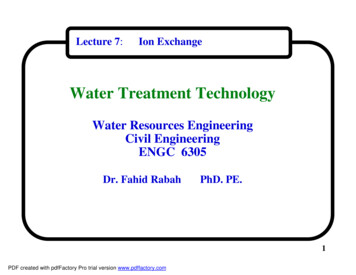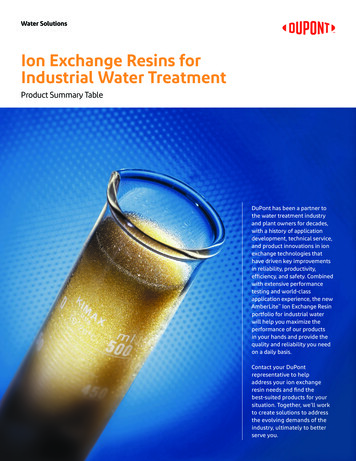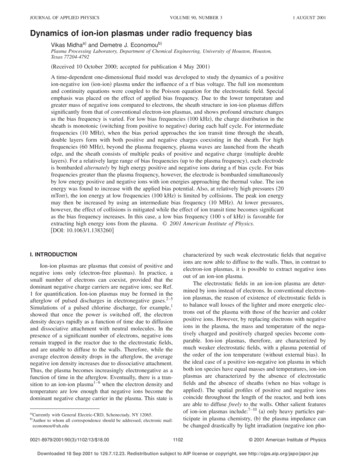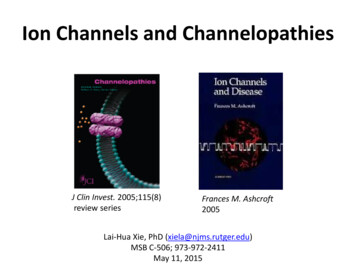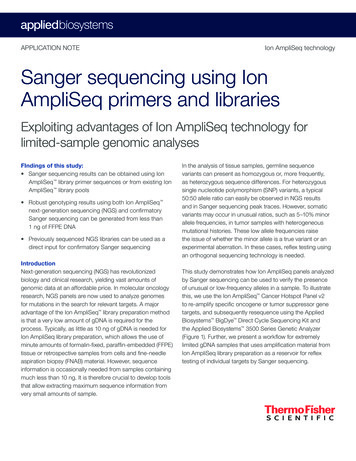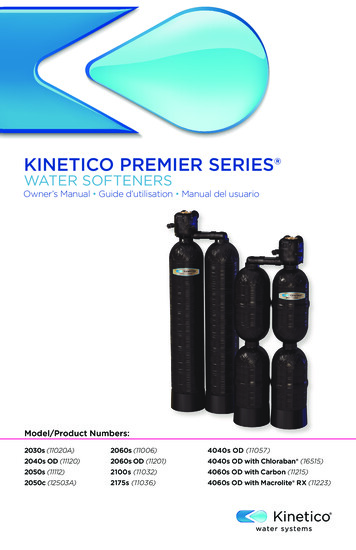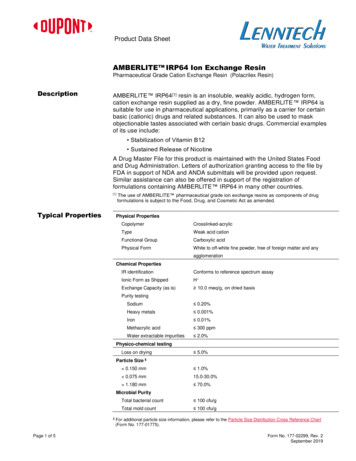
Transcription
Product Data SheetAMBERLITE IRP64 Ion Exchange ResinPharmaceutical Grade Cation Exchange Resin (Polacrilex Resin)DescriptionAMBERLITE IRP64[1] resin is an insoluble, weakly acidic, hydrogen form,cation exchange resin supplied as a dry, fine powder. AMBERLITE IRP64 issuitable for use in pharmaceutical applications, primarily as a carrier for certainbasic (cationic) drugs and related substances. It can also be used to maskobjectionable tastes associated with certain basic drugs. Commercial examplesof its use include: Stabilization of Vitamin B12 Sustained Release of NicotineA Drug Master File for this product is maintained with the United States Foodand Drug Administration. Letters of authorization granting access to the file byFDA in support of NDA and ANDA submittals will be provided upon request.Similar assistance can also be offered in support of the registration offormulations containing AMBERLITE IRP64 in many other countries.[1]Typical PropertiesThe use of AMBERLITE pharmaceutical grade ion exchange resins as components of drugformulations is subject to the Food, Drug, and Cosmetic Act as amended.Physical PropertiesCopolymerCrosslinked-acrylicTypeWeak acid cationFunctional GroupCarboxylic acidPhysical FormWhite to off-white fine powder, free of foreign matter and anyagglomerationChemical PropertiesIR identificationConforms to reference spectrum assayIonic Form as ShippedH Exchange Capacity (as is) 10.0 meq/g, on dried basisPurity testingSodium 0.20%Heavy metals 0.001%Iron 0.01%Methacrylic acid 300 ppmWater extractable impurities 2.0%Physico-chemical testingLoss on drying 5.0%Particle Size § 0.150 mm 1.0% 0.075 mm15.0-30.0% 1.180 mm 70.0%Microbial Purity§Page 1 of 5Total bacterial count 100 cfu/gTotal mold count 100 cfu/gFor additional particle size information, please refer to the Particle Size Distribution Cross Reference Chart(Form No. 177-01775).Form No. 177-02299, Rev. 2September 2019
IR SpectrumAMBERLITE IRP64 is manufactured in accordance with Good ManufacturingPractices (cGMP) for bulk pharmaceutical chemicals.Identification AMBERLITE IRP64 can be identified by infrared spectroscopy, asshown in the sample spectrum in Fig. 1.Figure 1. AMBERLITE IRP64 Resin IR SpectrumChemical StructureAMBERLITE IRP64 is derived from a porous copolymer of methacrylic acid anddivinylbenzene. The chemical structure of AMBERLITE IRP64 is shown in Figure2.Figure 2. AMBERLITE IRP64 Chemical StructureApplicationsApplications for AMBERLITE IRP64 include: Taste MaskingDrug StabilizationCarrier for Cationic DrugsControlled Release FormulationsAMBERLITE IRP64 provides a means for binding medicinal agents onto aninsoluble polymeric matrix. This affords an effective technique for overcomingPage 2 of 5Form No. 177-02299, Rev. 2September 2019
problems of taste and odor in oral dosage formulations as well as providing a matrixupon which a sustained or controlled release formulation can be developed.The high affinity of AMBERLITE IRP64 for the hydrogen ion results in readydesorption of adsorbed species by exposure to an acidic environment, such as thatexhibited in the stomach. This accounts for the higher desorption efficiencies versusa strong acid cation resin like AMBERLITE IRP69.Chemical instability problems can sometimes be resolved by adsorption on toAMBERLITE IRP64. For example, complexes of AMBERLITE IRP64 withcyanocobalamin (Vitamin B12), a nonionic material, have been used for many yearsas a means of providing a stable oral dosage form of this vitamin.Drug LoadingBatch equilibration is the preferred practice when loading a drug or other sorbateinto finely divided ion exchange operations normally used with ion exchangeresins.resin powders. Due to its fine particle size, AMBERLITE IRP64 does notlend itself to conventional columnar operations normally used with ion exchangeresins.The mobile, or exchangeable, cation in this resin is the hydrogen ion. In acidicenvironments (generally below pH 4) AMBERLITE IRP64 exists as the free acidin an essentially nonionic state. Adsorption (loading) onto this cation exchange resinis usually carried out at pH 6 or higher.The amount of drug loaded onto AMBERLITE IRP64 will be influenced by suchfactors as: the inherent affinity or selectivity between the ion exchange resin and thedrug.the concentration of the drug in the loading solution.the concentration and selectivity of competing cations.the pH of the loading solution.The rate of loading will be affected by the activity of the drug and its moleculardimensions as well as the extent to which the polymer phase is swollen duringloading.When utilizing a batch or equilibrium contact to load a drug or other anionic sorbateonto AMBERLITE IRP64, it may be desirable to load as much as possible of thesubstance of value onto the resin. Complete transfer of the drug from the loadingsolution is not likely in a single equilibrium stage. Accordingly, more than oneequilibration may be required in order to achieve the desired loading onto the resin.The use of two or more loading stages, separating the resin from the liquid phasebetween stages, is an effective means of achieving maximum loading of the drugonto the resin while maintaining minimum loss of drug from the liquid phase of thefinal stage.Carefully controlled laboratory experiments are required to establish precise loadingand elution conditions.Drug ReleaseThe rate and completeness of drug desorption in vivo will be controlled by thediffusion rate of the drug through the polymer phase of the resin, (usually a functionof molecular weight), the selectivity of the drug for the resin, and the concentrationof electrolytes particularly in the hydrogen ion, in the desorption environment.More hydrophobic drugs will usually elute from the resin at a lower rate, as willdrugs with a relatively high selectivity for the carboxylic acid functional structure inPage 3 of 5Form No. 177-02299, Rev. 2September 2019
the resin. Other resinsorbate interactions are possible, and these can have apronounced effect upon loading capacities and rates.ApplicationsReference ListAn example of this might be the presence of a transition metal in the structure of thesorbate molecule which can result in considerable selectivity through the formationof a coordination compound with the resin.Controlled/Sustained ReleaseLeo Corporation, 1973. Smoking substitutes and method of production. Patent GB1,325,011.Taste-MaskingDouglas, S.J. Glaxo Group Research Ltd, 1990. Process for the preparation of aranitidine resin absorbate. US 5219 563.Astruc, J., and A. Sambot, 1970. Ion-exchange resin: spiramycin compositions.Patent GB 1,180,233.Borodkin, S., and D.P. Sundberg, 1971. Chewable tablets including coated particlesof psuedo-ephedine-weak cation exchange resin. Patent US 3,594,470.Wilding, I.R., S.S. Davis, K.P. Steed, R.A. Sparrow, J. Westrup, and J.M.Hempenstall, 1994. Gastrointestinal transit of a drug-resinate administered as anoral suspension. Int. J. Pharm. 101: 263-268.OtherFretland, D.J., 1974. Use of ion-exchange resins for removing prostaglandins fromhuman urine prior to radioimunoassay. Prostaglandins 6 (5): 421-425.Miles Laboratories, Inc., 1970 Detection device for enzymes and other factors inbody fluids. Patent US 3,616,251. Kunin, R., S. Vetrano, and B. L. Libutti, 1990. Anovel approach to the use of ion exchange and adsorption media for the processingof pharmaceutical and biological substances. Reactive Polymers 13: 291-298.Pogocki, D., T. Ruman, M. Danilczuk, M. Danilczuk, M. Celuch, and E. WalajtysRode, 2007. Application of nicotine enantiomers, derivatives and analogues intherapy of neurogenerative disorders. Eur. J. Pharm. 563: 18-39.Page 4 of 5Form No. 177-02299, Rev. 2September 2019
ProductStewardshipDuPont has a fundamental concern for all who make, distribute, and use its products,and for the environment in which we live. This concern is the basis for our productstewardship philosophy by which we assess the safety, health, and environmentalinformation on our products and then take appropriate steps to protect employee andpublic health and our environment. The success of our product stewardship programrests with each and every individual involved with DuPont products—from the initialconcept and research, to manufacture, use, sale, disposal, and recycle of each product.Customer NoticeDuPont strongly encourages its customers to review both their manufacturing processesand their applications of DuPont products from the standpoint of human health andenvironmental quality to ensure that DuPont products are not used in ways for whichthey are not intended or tested. DuPont personnel are available to answer yourquestions and to provide reasonable technical support. DuPont product literature,including safety data sheets, should be consulted prior to use of DuPont products.Current safety data sheets are available from DuPont.Please be aware of the following: WARNING: Oxidizing agents such as nitric acid attack organic ion exchange resinsunder certain conditions. This could lead to anything from slight resin degradation toa violent exothermic reaction (explosion). Before using strong oxidizing agents,consult sources knowledgeable in handling such materials.Regulatory Noteinfo@lenntech.com Tel. 31-152-610-900www.lenntech.com Fax. 31-152-616-289All information set forth herein is for informational purposes only. This information is general information and may differ fromthat based on actual conditions. Customer is responsible for determining whether products and the information in this documentare appropriate for Customer's use and for ensuring that Customer's workplace and disposal practices are in compliance withapplicable laws and other government enactments. The product shown in this literature may not be available for sale and/oravailable in all geographies where DuPont is represented. The claims made may not have been approved for use in allcountries. Please note that physical properties may vary depending on certain conditions and while operating conditions statedin this document are intended to lengthen product lifespan and/or improve product performance, it will ultimately depend onactual circumstances and is in no event a guarantee of achieving any specific results. DuPont assumes no obligation or liabilityfor the information in this document. References to “DuPont” or the “Company” mean the DuPont legal entity selling theproducts to Customer unless otherwise expressly noted. NO WARRANTIES ARE GIVEN; ALL IMPLIED WARRANTIES OFMERCHANTABILITY OR FITNESS FOR A PARTICULAR PURPOSE ARE EXPRESSLY EXCLUDED. No freedom frominfringement of any patent or trademark owned by DuPont or others is to be inferred.DuPont , the DuPont Oval Logo, and all trademarks and service marks denoted with , or are owned by affiliates ofDuPont de Nemours, Inc. unless otherwise noted. 2019 DuPont.Page 5 of 5Form No. 177-02299, Rev. 2September 2019
environmental quality to ensure that DuPont products are not used in ways for which they are not intended or tested. DuPont personnel are available to answer your questions and to provide reasonable technical support. DuPont product literature, including safety data sheets, should be consulted prior to use of DuPont products.

